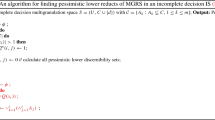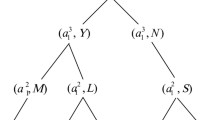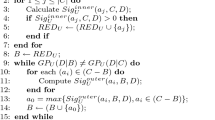Abstract
For incomplete ordered decision information systems (IODIS), the interval, defined as an intersection of the dominating set of one object and the dominated set of another object, is regarded as the basic knowledge granule used for defining the lower and upper approximations. It is shown in this paper that such knowledge granule can help induce the “at least and at most” decision rules for IODIS, which would assign an object to more precise decision classes. In order to compute the optimal “at least and at most” decision rules, the concept of relative reduct of an interval is proposed, and the corresponding discernibility function is constructed for computing the relative reduct. Finally, an illustrative example is provided to demonstrate the advantages of our method in decision making.
Similar content being viewed by others
Explore related subjects
Discover the latest articles, news and stories from top researchers in related subjects.References
Pawlak Z (1991) Rough sets: theoretical aspects of reasoning about data. Kluwer Academic Publishers, London
Pawlak Z, Skowron A (2007) Rough sets and Boolean reasoning. Inf Sci 177:41–73
Wang XZ, Tsang ECC, Zhao SY, Chen DG, Yeung DS (2007) Learning fuzzy rules from fuzzy samples based on rough set technique. Inf Sci 177:449–451
Leung Y, Wu WZ, Zhang WX (2006) Knowledge acquisition in incomplete information systems: a rough set approach. Eur J Oper Res 168:164–180
Yao YY, Zhao Y (2008) Discernibility matrix simplification for constructing attribute reducts. Inf Sci 179(7):867–882
Guan YY, Wang HK, Wang Y, Yang F (2009) Attribute reduction and optimal decision rules acquisition for continuous valued information systems. Inf Sci 179:2974–2984
Guan YY, Wang HK (2006) Set-valued information systems. Inf Sci 176:2507–2525
Wu WZ, Zhang WX, Li HZ (2003) Knowledge acquisition in incomplete fuzzy information systems via the rough set approach. Exp Syst 20(5):280–286
Zhang WX, Mi JS, Wu WZ (2003) Approaches to knowledge reductions in inconsistent systems. Int J Intell Syst 18:989–1000
Kryszkiewicz M (1999) Rules in incomplete information systems. Inf Sci 113:271–292
Kryszkiewicz M (1998) Rough set approach to incomplete information systems. Inf Sci 112:39–49
Hu XH, Cercone N (1995) Learning in relational databases: a rough set approach. Int J Comput Intell 11(2):323–337
Ma FF, Guan YY, Jiang HB, Chen WJ, Wang HK (2012) The comparative study of pawlak rough set model and dominance-based rough set approach. J Comput Inf Syst 8(11):4705–4715
Greco S, Matarazzo B, Slowinski R (2001) Rough sets theory for multicriteria decision analysis. Eur J Oper Res 129:1–47
Greco S, Matarazzo B, Slowinski R (2002) Rough approximation by dominance relation. Int J Intell Syst 17:153–171
Shao MW, Zhang WX (2005) Dominance relation and rules in an incomplete ordered information system. Int J Intell Syst 20:13–27
Yang XB, Yang JY, Wu C, Yu DJ (2008) Dominance-based rough set approach and knowledge reduct in incomplete ordered information system. Inf Sci 178:1219–1234
Qian YH, Dang CY, Liang JY, Tang D (2009) Set-valued ordered information systems. Inf Sci 179:2809–2832
Luo C, Li TR, Chen HM, Liu D (2013) Incremental approaches for updating approximations in set-valued ordered information systems. Knowl-Based Syst 50:218–233
Luo C, Li TR, Chen HM (2014) Dynamic maintenance of approximations in set-valued ordered decision systems under the attribute generalization. Inf Sci 257:210–228
Wang HK, Guan YY, Huang JL, Shen JT (2015) Decision rules acquisition for inconsistent disjunctive set-valued ordered decision information systems. Math Probl Eng, Article ID 936340
Dembczynski K, Greco S, Slowinski R (2009) Rough set approach to multiple criteria classification with imprecise evaluations and assignments. Eur J Oper Res 198:626–636
Qian YH, Liang JY, Dang CY (2008) Interval ordered information systems. Comput Math Appl 56:1994–2009
Yang XB, Yu DJ, Yang JT, Wei LH (2009) Dominance-based rough set approach to incomplete interval-valued information system. Data Knowl Eng 68(11):1331–1347
Hu QH, Pan WW, Zhang L, Zhang D, Song YP, Guo MZ, Yu DR (2012) Feature selection for monotonic classification. IEEE Trans Fuzzy Syst 20(1):69–81
Huang B (2011) Graded dominance interval-based fuzzy objective information systems. Knowl-Based Syst 24:1004–1012
Huang B, Li HX, Wei DK (2012) Dominance-based rough set model in intuitionistic fuzzy information systems. Knowl-Based Syst 28:115–123
Huang B, Wei DK, Li HX, Zhuang YL (2013) Using a rough set model to extract rules in dominance-based interval-valued intuitionistic fuzzy information systems. Inf Sci 221:215–229
Ziarko W (1993) Variable precision rough set model. J Comput Syst Sci 46(1):39–59
Greco S, Matarazzo B, Slowinski R, Stefanowski J (2001) Variable consistency model of dominance-based rough set approach. In: Ziarko W, Yao Y (eds) Rough sets and current trends in computing, LNAI 2005. Springer, Berlin, pp 170–181
Blaszczynski J, Greco S, Slowinski R, Szelag M (2009) Monotonic variable consistency rough set approaches. Int J Approx Reas 50:979–999
Blaszczynski J, Slowinski R, Szelag M (2011) Sequential covering rule induction algorithm for variable consistency rough set approaches. Inf Sci 181:987–1002
Ma FF, Guan YY, Du XZ, Huang JL (2013) The study of variable consistency dominance-based rough set approach. J Comput Inf Syst 9(4):1369–1379
Inuiguchi M, Yoshioka Y, Kusunoki Y (2009) Variable-precision dominance-based rough set approach and attribute reduction. Int J Approx Reas 50(8):1199–1214
Blaszczynski J, Greco S, Slowinski R (2007) Multi-criteria classification—a new scheme for application of dominance-based decision rules. Eur J Oper Res 181:1030–1044
Blaszczynski J, Greco S, Slowinski R (2012) Inductive discovery of laws using monotonic rules. Eng Appl Artif Intell 25:284–294
Guan YY, Wang HK, Xu FS, Jiang HB (2013) A new dominance-based rough set model based on interval knowledge granules. In: The proceedings of 2013 10th international conference on fuzzy systems and knowledge discovery, July 23–25, Shenyang, China, pp 559–563
Guan YY, Wang HK, Chen WJ, Chen B (2013) Definite reducts in ordered decision information systems. In: The proceedings of sixth international conference on advanced computational intelligence (ICACI2013), October 19–21, Hangzhou, China, pp 91–95
Guan YY, Wang HK, Xu FS (2014) Interval decision rules acquisition in ordered decision information systems. Chin J Control Dec 29(9):1611–1616
Stefanowski J, Tsoukias A (2001) Incomplete information tables and rough classification. Comput Intell 17:545–566
Skowron A, Rauszer C (1992) The discernibility matrices and functions in information systems. In: Slowinski R (ed) Intelligent decision support: handbook of applications and advances of rough sets theory. Kluwer Academic Publisher, Dordrecht, pp 331–362
Acknowledgments
This research is supported by the National Natural Science Foundation of China (61070241) and the Shandong Provincial Natural Science Foundation, China (ZR2013AQ007).
Author information
Authors and Affiliations
Corresponding author
Rights and permissions
About this article
Cite this article
Huang, J., Guan, Y., Du, X. et al. Decision rules acquisition based on interval knowledge granules for incomplete ordered decision information systems. Int. J. Mach. Learn. & Cyber. 6, 1019–1028 (2015). https://doi.org/10.1007/s13042-015-0408-8
Received:
Accepted:
Published:
Issue Date:
DOI: https://doi.org/10.1007/s13042-015-0408-8




